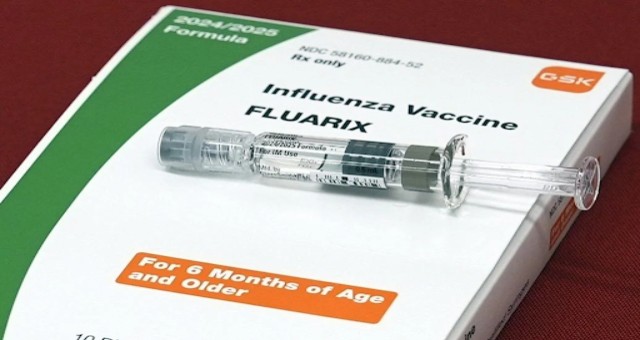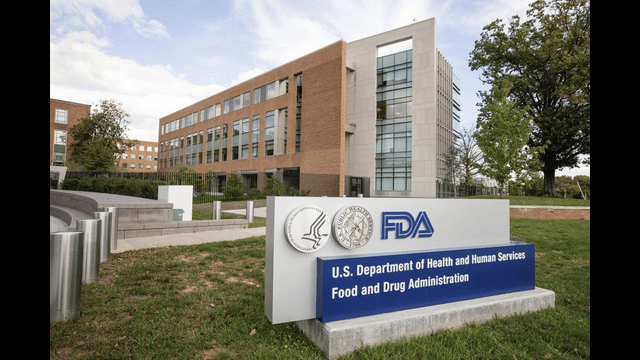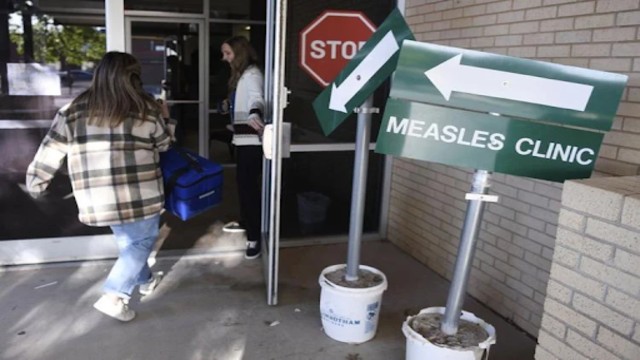
A flu vaccine is displayed at a pharmacy in New York, on Tuesday, Sept. 24, 2024. (AP Photo via thecanadianpress)
The ongoing winter virus season in the U.S. has reached significant intensity, with flu activity hitting its highest levels in over a decade. According to the Centers for Disease Control and Prevention (CDC), the percentage of doctor’s visits due to flu-like symptoms has surpassed the peak of any flu season since the 2009-2010 swine flu pandemic.
While flu remains the primary concern, COVID-19 cases appear to be declining based on hospital reports and CDC projections. Additionally, cases of Respiratory Syncytial Virus (RSV) have been decreasing nationwide. However, respiratory illnesses, in general, continue to surge, putting pressure on healthcare systems.
Flu Outbreak Forces School Closures
The flu has caused disruptions in several states, leading to temporary school closures. In Texas, the Godley Independent School District, with 3,200 students, shut down for three days last week. The decision was made after 650 students and 60 staff members were absent due to illness. According to district spokesperson Jeff Meador, the flu outbreak has been one of the worst in recent memory, with some cases of strep throat also reported.
Flu Statistics Paint a Concerning Picture
As of this season, CDC estimates indicate at least 24 million flu infections, 310,000 hospitalizations, and 13,000 deaths, including 57 children. Historically, flu cases peak around February, but current trends show widespread infections across the country.
Last week, 43 states reported high or very high flu activity, with the most severe outbreaks concentrated in the South, Southwest, and western U.S. In Rochester, New York, flu cases remain significant. However, Dr. Elizabeth Murray from the University of Rochester Medical Center notes that RSV and even COVID-19 continue to affect patients, particularly infants.
“All respiratory illnesses seem to be circulating aggressively,” Murray said, highlighting the ongoing burden on hospitals and healthcare facilities.
CDC Cautious in Assessing Flu Severity
The CDC has been monitoring the flu’s impact closely but has not provided interviews regarding recent trends. However, a spokesperson acknowledged that flu-like illness rates are at their highest recorded levels this season. Despite this, determining overall severity remains complex, as flu season assessments are recalculated yearly.
In late January, the CDC classified this flu season as “moderate” in severity. However, given the recent spike in cases, experts continue to evaluate the situation.
Vaccination Rates and Prevention Measures
Health officials continue to recommend annual flu shots for everyone aged six months and older. However, vaccination rates have remained stagnant. This winter, 44% of adults received flu shots, similar to last year. Flu vaccination coverage among children has dropped to 45%, lower than the usual 50%.
COVID-19 vaccination rates remain low as well. As of late January, 23% of U.S. adults were up to date on their COVID-19 shots, slightly higher than last year’s 20%. Children's COVID-19 vaccination rates remain unchanged at 12%.
The CDC has not yet released data on this season’s flu vaccine effectiveness. However, testing indicates that two strains—Type A H1N1 and Type A H3N2—are responsible for most flu cases. Meanwhile, health officials are closely monitoring a bird flu strain, Type A H5N1, which has affected millions of animals but has only been found in 67 human cases in the U.S.
Tips to Prevent Flu and Other Viruses
Medical experts stress the importance of taking preventive measures to reduce virus transmission. The following steps can help:
- Avoid touching your eyes, nose, and mouth, as viruses spread easily through contact.
- Wash hands frequently with soap and water.
- Disinfect commonly touched surfaces to limit the spread of germs.
- Maintain distance from sick individuals to prevent infection.
As flu cases remain high, experts urge people to stay cautious, get vaccinated, and practice good hygiene to reduce the risk of illness this season.















